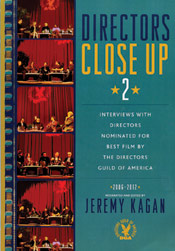(Scarecrow Press, 383 pages, $38)
By Jeremy Kagan

Each awards season, the Directors Guild of America’s nominees for best feature film gather for an in-depth discussion of their work at the annual Meet the Nominees Symposium. In a spirit of colorful camaraderie, the panelists share their processes, struggles, and unique artistic visions with their fellow membersÑup close and personal. The heart of these fascinating and informative conversations is on full display in Jeremy Kagan’s Directors Close Up 2.
Since 1992, when the Special Projects Committee launched the symposium, it has become one of the most popular annual Guild events. Realizing that the wealth of insights from the most prominent directors in the industry; Steven Spielberg, Kathryn Bigelow, David Fincher, and Martin Scorsese, to name just a few; would be an invaluable resource for directors everywhere, as well as film students and moviegoers, Kagan, who serves as the event’s moderator, culled together the first compilation of the panel’s interviews in 2006.
The new edition, Directors Close Up 2, which brings us up to the 2012 symposium, is, at its core, a reference tool that is rich with personal anecdotes and practical information about the nuts and bolts of filmmaking. From the technical aspects of the craft to dealing with the individual temperament of cast and crew, the directors leave no stone unturned. The book is divided into four parts: preproduction, production, postproduction, and, in closing, a section in which directors reflect on “The Worst and the Best” moments of making their film. There is also an entire section of additional materials such as storyboard sequences, script pages with notes, shot lists, production art, behind-the-scenes photos, personal sketches, and even notes written on Post-its.
The interviews are specific to the nominated films. Therefore, James Cameron’s thoughts on emerging technology are focused on his 2009 film Avatar; Ang Lee’s belief in balanced preparation with actors is in reference to his 2005 film Brokeback Mountain.
Since no two directors approach their work exactly alike, it’s fascinating to see how their creative processes intertwine with and circle each other; sometimes colliding head-on in complete agreement, other times bouncing off in opposite directions. The Coen Bros. careful, determined storyboarding technique (“We do storyboard everything”), is in stark contrast with Alexander Payne who states categorically that he’s “never storyboarded a day in my life.”
“Making a film is like a song,” says David O. Russell, “everybody starts to learn the words and hopefully you’re all singing the same song...the same melody.” And while no two directors spotlighted in this volume sing their songs in quite the same way, it’s a treat to hear how they sound.
Review written by Carley Johnson